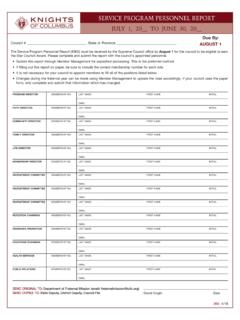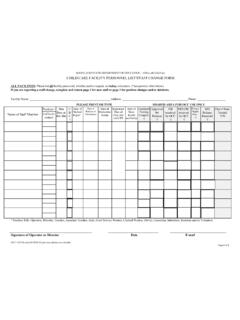Transcription of GENERAL RETENTION SCHEDULE #26 - Michigan
1 GENERAL RETENTION SCHEDULE #26 LOCAL GOVERNMENT HUMAN RESOURCES INTRODUCTION Public Records The Michigan Freedom of Information Act (FOIA) (MCL ) defines public records as recorded information prepared, owned, used, in the possession of, or retained by a public body in the performance of an official function, from the time it is created. RETENTION and Disposal Schedules Michigan law (MCL and ) requires that all public records be listed on an approved RETENTION and Disposal SCHEDULE that identifies the minimum amount of time that records must be kept to satisfy administrative, legal, fiscal and historical needs. Local situations may require RETENTION beyond the periods listed, and nothing prevents an office from retaining records longer than the specified period of time. Schedules also identify when records may be destroyed, and when certain records can be sent to the Archives of Michigan for permanent preservation.
2 Records cannot be destroyed unless their disposition is authorized by an approved RETENTION and Disposal SCHEDULE . All schedules are approved by the Records Management Services, the Archives of Michigan and the State Administrative Board. There are two types of schedules that government agencies may use: A GENERAL SCHEDULE will cover records that are common to a particular type of government agency, such as a human resources office. GENERAL schedules may not address every single record that a particular office may have in its possession. GENERAL schedules do not mandate that any of the records listed on the SCHEDULE be created. However, if they are created in the normal course of business, the SCHEDULE establishes a minimum RETENTION period for them. Any record that is not covered by a GENERAL SCHEDULE must be listed on an agency-specific SCHEDULE that will address records that are unique to a particular government agency.
3 Agency-specific schedules always supersede GENERAL schedules. Agency-specific schedules only address the records of the agency named on the SCHEDULE , and may not be used by another agency. This SCHEDULE covers personnel and payroll records maintained by local governments including counties, cities, townships, villages, school districts, local authorities, public colleges and public universities. Unofficial Documents GENERAL SCHEDULE #1 addresses the RETENTION of nonrecord materials. These documents are broadly defined as drafts, duplicates, convenience copies, publications and other materials that do not document agency activities. These materials can be disposed of when they have served their intended purpose. Government agencies need to identify the office of record when multiple offices possess copies of the same record. The office of record is responsible for following the RETENTION period that is specified, duplicates do not need to be retained.
4 A more comprehensive definition of nonrecords can be found in the approved SCHEDULE (available online at ). Record Maintenance Records can exist in a wide variety of formats, including paper, maps, photographs, microfilm, digital images, e-mail messages, databases, etc. The RETENTION periods listed on this GENERAL SCHEDULE do not specify the format that the record may exist in, because each government agency that adopts this SCHEDULE may choose to retain its records using different recording media. Government agencies are responsible for ensuring that all of their records (regardless of format) are properly retained and remain accessible during this entire RETENTION period. All records need to be stored in a secure and stable environment that will protect them from tampering, damage and degradation. Electronic records are dependent upon specific hardware and software to be accessed and used.
5 It is important to understand that the original technology that is used to create electronic records will eventually become obsolete. As a result, government agencies should work with their information technology staff to develop preservation plans for retaining electronic records with long-term (more than 10 years) RETENTION requirements. Various laws (including the Records Reproduction Act, MCL ) identify acceptable formats for retaining public records; agencies are responsible for understanding and complying with these laws. Suspending Destruction Government agencies must immediately cease the destruction of all relevant records (even if destruction is authorized by an approved RETENTION and Disposal SCHEDULE ) if they receive a FOIA request, if they believe that an investigation or litigation is imminent, or if they are notified that an audit, investigation or litigation has commenced.
6 If relevant records exist in electronic formats (such as e-mail, digital images, word processed documents, databases, backup tapes, etc.), the agency may need to notify its information technology staff. Failure to cease the destruction of relevant records could result in penalties. HAL Can Help! The State of Michigan Records Management Services is available to assist government agencies with their questions about record RETENTION and acceptable recording media. Agencies may contact the Records Management Services at (517) 335-9132. Additional information is also available from the Records Management Services website , including records management manuals, GENERAL schedules, e-mail RETENTION guidelines, microfilming standards and digital imaging standards, etc. Page 1 GENERAL RETENTION SCHEDULE #26 Local Government Human Resources Item Total Number Series Title and Description RETENTION PERM = Permanent ACT = Active SUP = Superseded CR = Creation Date FY = Fiscal Year EVT = Event EXP = Expiration personnel 100A personnel Files ACT+6 These files are maintained on each employee of the local government.
7 They document hiring, promotion, demotion, transfer, layoff, performance, discipline, termination, etc. They may include employment applications and resumes, job descriptions and classification history, clippings, correspondence, service record change forms, attendance, evaluations, investigations, COBRA, training records, blood borne pathogen training, contracts, disciplinary records, layoff notices, recall notices, apprenticeships, transcripts, tuition reimbursement, policy acknowledgements, property sign-out forms, certifications, current driver s licenses, driving records, police accident reports, exit interviews, severance agreements, etc. ACT = term of employment. 100B personnel Files Temporary Employees ACT+6 These files are maintained on all temporary, seasonal and student employees.
8 They may contain the same documents listed in item #100A, as well as work permits and certificates of age for minors. ACT = term of employment. 100C personnel Files Contractual Employees EXP+6 These files are maintained on all contractual employees. They may include 1099 forms, W-9 forms, verification of insurance, copies of contracts, etc. 101 Employee Database ACT+6 Local governments may maintain electronic data to administer personnel and payroll functions including timekeeping, tenure, payroll, retirement, etc. ACT = term of employment. 102 Employment Verification Forms CR+30 days These forms are received from mortgage or credit companies that want to verify the employment status of an employee. 103 Background Files ACT+6 These files document that the local government conducted appropriate background checks on employees.
9 These files may contain release forms Page 2 GENERAL RETENTION SCHEDULE #26 Local Government Human Resources Item Total Number Series Title and Description RETENTION PERM = Permanent ACT = Active SUP = Superseded CR = Creation Date FY = Fiscal Year EVT = Event EXP = Expiration to conduct criminal history checks, fingerprint checks and professional conduct checks, and the results of those checks. They may also include driving records, drug and alcohol tests, physical exam results, polygraph test results, credit history reports, etc. ACT = term of employment. 104 Medical Files ACT+30 These files document private medical information for a specific employee, including disability accommodations.
10 They may contain insurance forms, physician correspondence, tuberculosis tests, polygraph test results, off-work notices, Family Medical Leave Act forms and requests, long and short-term disability paperwork, drug and alcohol tests, physical exams, accident reports, personal requests, etc. [29 CFR (d)] These records must be retained separately from personnel files (see item #100A). The medical records of employees who have worked for less than 1 year for the employer need not be retained beyond the term of employment, if they are provided to the employee upon the termination of employment. ACT = term of employment. Note: this series does not include the official copy of insurance claims, which are usually retained by the business or finance office. 105 Employee Test Results CR+6 Some employees attend professional development, continuing education, licensing and/or certification training.











